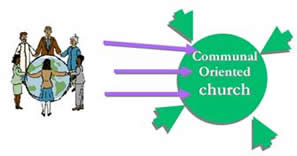FEBI goal: missional churches
FEBInternational, the mission arm of the Fellowship of Evangelical Baptist Churches of Canada, is a church planting mission and has been from its inception over 40 years ago. Recently under the leadership of the current director, Richard Flemming, this goal has been clarified as planting missional churches. This is not merely a restatement of the original goal of establishing healthy, growing churches cross culturally; it introduces a particular missional orientation within a congregation that distinguishes such a church from the more prevalent communal oriented congregation 1.
When Karen and I went to Pakistan as FEBI missionaries to the Sindhi people of Pakistan, part of our mandate was to plant a church. When people became followers of Christ, we taught them the significance of being a community of faith. We studied God’s word together and gathered for prayer, worship and fellowship. We sought to develop a vision of a community centered on faith in Christ. However, this group failed to become an established local church. A large part of this failure was an incomplete vision. The group lacked a missional purpose towards the surrounding community as part of their reason for being. The vision we promoted of the body of Christ separate from the world was insufficient. What was required was a unifying identity of being called to participate in God’s mission to the world.
The primary orientation determines the missional church
Essentially a missional church is a congregation whose primary goal is gospel transformation in the world. The organization and function of the missional church flows out of the core goal of being a part of God’s mission, which is to bring change (redemption) within the surrounding community. This contrasts the communal oriented church that primarily seeks to provide an expression of the kingdom of God separate from the world. Of course, the missional church requires communal expressions in order to function and the communal oriented church will have programs focused on reaching the lost. The difference between the two is found in the underlying purpose, the essential identity and the primary orientation that shapes the teaching, structure and activities of each church. This article will clarify the important distinction between a local church that has as its primary concern a communal orientation and one that has amissional orientation.
Definitions of missional and communal oriented churches
In these articles a basic assumption is that the form or structure of a church is determined by culture, rather than prescribed by biblical directives. Thus the organization and leadership of a local congregation of believers is shaped by the demands of their particular setting as they seek to apply Jesus’ teaching to their lives. Priority is given to the function of the church. From this perspective a working definition of a “local church” can be phrased as “the communal relationship between followers of Christ within which spiritual growth occurs.”
 With this understanding a missional church can be defined as the communal relationship between followers of Christ which stems from intentionalgospel transformation in the world. In the illustration the green arrows represent the primary goal of the missional church to impact the world with the kingdom of God. The purple arrows represent the way this task shapes the form and function of the communal aspects of the church in order to facilitate that goal.
With this understanding a missional church can be defined as the communal relationship between followers of Christ which stems from intentionalgospel transformation in the world. In the illustration the green arrows represent the primary goal of the missional church to impact the world with the kingdom of God. The purple arrows represent the way this task shapes the form and function of the communal aspects of the church in order to facilitate that goal.
 What I am referring to as the communal oriented church can be defined as the organized relationships between followers of Christ as an expression of the transforming power of the gospel. The green arrows represent the primary concern of being an expression of the kingdom of God. The purple arrows represent the secondary concern to bring people into this community of believers.
What I am referring to as the communal oriented church can be defined as the organized relationships between followers of Christ as an expression of the transforming power of the gospel. The green arrows represent the primary concern of being an expression of the kingdom of God. The purple arrows represent the secondary concern to bring people into this community of believers.
The following three metaphors help illustrate this contrast between missional and communal oriented churches.
I. Business metaphor.
 The communal oriented church can be compared to a theater. The goal is to encourage people to come in and be a part of what is happening within the program of the organization. To facilitate this the atmosphere is comfortable and appealing, the programs presented are satisfying, and the hope is that people will want to come back and support the agenda. For a theater the agenda is that people enjoy the movie, for the church the agenda is that people should become committed participants.
The communal oriented church can be compared to a theater. The goal is to encourage people to come in and be a part of what is happening within the program of the organization. To facilitate this the atmosphere is comfortable and appealing, the programs presented are satisfying, and the hope is that people will want to come back and support the agenda. For a theater the agenda is that people enjoy the movie, for the church the agenda is that people should become committed participants.
For example, a member of one church made the suggestion that “we should show Christian movies in our building on Sunday evening” as an outreach program to bring people into the church.
 The missional church is more like a computer company whose goal is to bring the product into the homes where people live. Their efforts are focused on making the product relevant and appealing to the needs of the person within their context. For example, my wife, Karen, buys her computers from one local company because it provides excellent support coupled with the technology to design computers to meet their customers’ business needs. Their offices and organization are shaped to fulfill this goal. In a similar fashion the aim of the missional church is to make the gospel relevant to people where they live, rather than seeking to create appealing programs that will draw people in.
The missional church is more like a computer company whose goal is to bring the product into the homes where people live. Their efforts are focused on making the product relevant and appealing to the needs of the person within their context. For example, my wife, Karen, buys her computers from one local company because it provides excellent support coupled with the technology to design computers to meet their customers’ business needs. Their offices and organization are shaped to fulfill this goal. In a similar fashion the aim of the missional church is to make the gospel relevant to people where they live, rather than seeking to create appealing programs that will draw people in.
II. Nature metaphor
 In E. R. McManus provides a powerful river metaphor to illustrate the dynamic way church relates to culture 2. I will take some liberty with the picture by adding fish. The missional church lives dangerously in the rapids with the fish that are struggling to swim upstream, while the communal oriented church scoops up the fish in buckets and puts them
In E. R. McManus provides a powerful river metaphor to illustrate the dynamic way church relates to culture 2. I will take some liberty with the picture by adding fish. The missional church lives dangerously in the rapids with the fish that are struggling to swim upstream, while the communal oriented church scoops up the fish in buckets and puts them  in quiet pools on the shore. Rather than seeking protection and security within institutional walls, the missional church trusts in the endurance and indestructibility of the gospel and lives recklessly within the rushing rapids of the world. Leaders of the communal oriented church standing on the edge recognize the dangers of syncretism and compromise, "Be careful, you are getting too close to the rocks!" The riverbank represents a controlled environment that provides a place of refuge and facilitates security from destructive influences in the world. However, for the missional church, the task of the leader is three-fold: to push believers towards the rapids, equip them to thrive in that environment, and keep them away from the rocks.
in quiet pools on the shore. Rather than seeking protection and security within institutional walls, the missional church trusts in the endurance and indestructibility of the gospel and lives recklessly within the rushing rapids of the world. Leaders of the communal oriented church standing on the edge recognize the dangers of syncretism and compromise, "Be careful, you are getting too close to the rocks!" The riverbank represents a controlled environment that provides a place of refuge and facilitates security from destructive influences in the world. However, for the missional church, the task of the leader is three-fold: to push believers towards the rapids, equip them to thrive in that environment, and keep them away from the rocks.
In FEBInternational we noted a tendency to plant churches that are safe backwaters; controlled environments that are easily measurable. As a result people are taught to be content to scoop out fish rather than swimming in the rapids. When this happens, the maintenance of the community of believers becomes the aim of the church rather than the transformation of society. By developing missional churches we hope to initiate relevant and visionary communal networks of people whose primary desire is to make a gospel impact within their environment.
III. Transportation metaphor
The communal oriented church can be compared to a gas station that offers a rest stop for travelers from the rush of the road. It provides the power to keep going and support for mechanical problems to ensure that the car will continue to run well.
It provides the power to keep going and support for mechanical problems to ensure that the car will continue to run well.
On the other hand, the missional church is more interested in road construction. Roads determine the ability of the travelers to reach their destination as they drive their cars. This includes the provision of navigational clues (signs, paint) as well as danger signs to keep people from straying during their life journey. It also provides roadside assistance – “real ministry in real time” as expressed by the slogan of the FEBCC Chaplaincy program.
Next: Examples and rationale
A missional church cannot survive without healthy communal relationships in the body of Christ. Unfortunately, a communal oriented church can continue to function without relevant and significant impact on the surrounding community. The following article will provide examples of the different perspectives that develop from these contrasting orientations as well as provide further detail concerning the rationale behind FEBInternational’s desire to plant missional churches.
- _______________
- (1) Some literature on the missional church contrasts missional with institutional, traditional or attractional and the latter terms are generally used in a pejorative manner. I am attempting to avoid the negative implication by using the term communal in order to affirm this important and legitimate aspect of church life. The key to distinguishing a missional from a communal focused church is its primary orientation.
- (2) E. R. McManus, “The Global Intersection” in The Church in Emerging Culture, Ed. L. Sweet. (Grand Rapids: Zondervan, 2003), 237.
